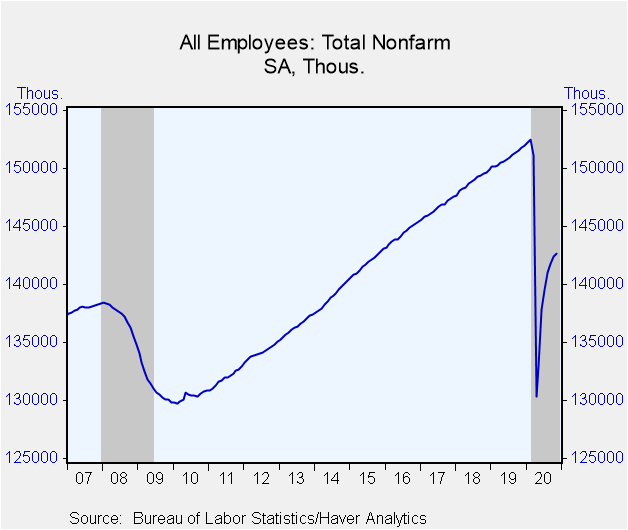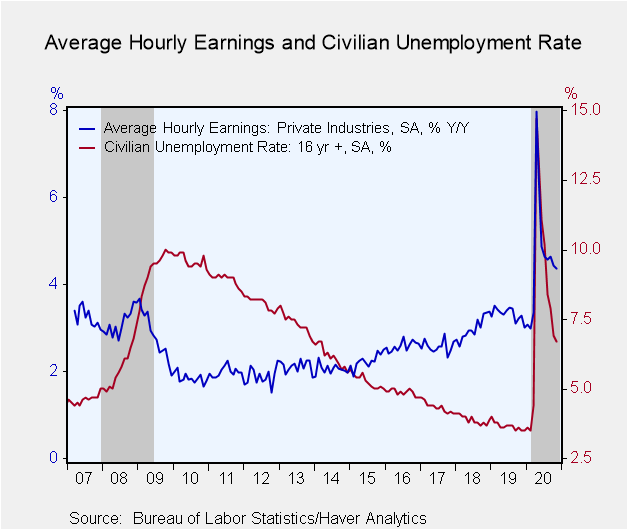 Global| Dec 04 2020
Global| Dec 04 2020U.S. Payroll Growth Slows Broadly
by:Tom Moeller
|in:Economy in Brief
Summary
• Job gains held back as coronavirus spreads. • Earnings growth picks up. • Jobless rate declines to eight-month low. The rate of labor market improvement has slowed following an initial bounce-back from recession declines. Nonfarm [...]
• Job gains held back as coronavirus spreads.
• Earnings growth picks up.
• Jobless rate declines to eight-month low.
The rate of labor market improvement has slowed following an initial bounce-back from recession declines. Nonfarm payroll employment increased 245,000 during November (-6.0% y/y) after rising 610,000 in October, revised from 638,000, and 711,000 in September, revised from 672,000. August's gain of 1.493 million was unchanged. This was the weakest of seven consecutive months of job gain. A 490,000 employment increase had been expected in the Action Economics Forecast Survey. The estimates amongst 25 forecasters had ranged from 320,000 to 700,000.
Average hourly earnings increased 0.3% (4.4% y/y) last month following two months of 0.1% improvement. It was the largest increase in three months. No change in earnings had been expected.
The unemployment rate fell to 6.7% during November from October's 6.9%. A decline to 6.8% had been expected. Employment in the household survey fell 74,000 (-5.6% y/y) after increasing 2.243 million in October while the labor force declined 400,000 (-2.4% y/y) after rising 724,000 in October. The overall jobless rate, including those who were marginally attached or working part-time for economic reasons, slipped to 12.0% from 12.1%, its lowest point since March.
The employment & earnings data are collected from surveys taken each month during the week containing the 12th of the month. The labor market data are contained in Haver's USECON database. Detailed figures are in the EMPL and LABOR databases. The expectations figures are in the AS1REPNA database.
| Employment (SA, M/M Change, 000s) | Nov | Oct | Sep | Nov Y/Y | 2019 | 2018 | 2017 |
|---|---|---|---|---|---|---|---|
| Payroll Employment | 245 | 610 | 711 | -6.0% | 1.4% | 1.6% | 1.6% |
| Previous Estimate | -- | 638 | 672 | -- | -- | -- | -- |
| Manufacturing | 27 | 33 | 60 | -4.8 | 1.2 | 2.0 | 0.7 |
| Construction | 27 | 72 | 35 | -2.4 | 2.8 | 4.6 | 3.6 |
| Private Service-Producing | 289 | 770 | 833 | -6.5 | 1.5 | 1.5 | 1.8 |
| Government | -99 | -267 | -219 | -5.3 | 0.6 | 0.5 | 0.4 |
| Average Weekly Hours - Private Sector | 34.8 | 34.8 | 34.8 | 34.3 | 34.4 | 34.5 | 34.4 |
| Private Sector Average Hourly Earnings (%) | 0.3 | 0.1 | 0.1 | 4.4 | 3.3 | 3.0 | 2.6 |
| Unemployment Rate (%) | 6.7 | 6.9 | 7.9 | 3.5 | 3.7 | 3.9 | 4.3 |
Tom Moeller
AuthorMore in Author Profile »Prior to joining Haver Analytics in 2000, Mr. Moeller worked as the Economist at Chancellor Capital Management from 1985 to 1999. There, he developed comprehensive economic forecasts and interpreted economic data for equity and fixed income portfolio managers. Also at Chancellor, Mr. Moeller worked as an equity analyst and was responsible for researching and rating companies in the economically sensitive automobile and housing industries for investment in Chancellor’s equity portfolio. Prior to joining Chancellor, Mr. Moeller was an Economist at Citibank from 1979 to 1984. He also analyzed pricing behavior in the metals industry for the Council on Wage and Price Stability in Washington, D.C. In 1999, Mr. Moeller received the award for most accurate forecast from the Forecasters' Club of New York. From 1990 to 1992 he was President of the New York Association for Business Economists. Mr. Moeller earned an M.B.A. in Finance from Fordham University, where he graduated in 1987. He holds a Bachelor of Arts in Economics from George Washington University.








